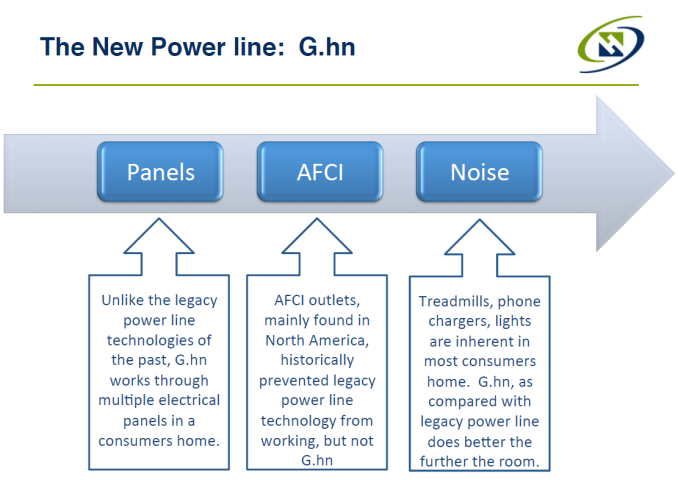Comtrend PG-9172 Powerline Adapter Review: G.hn Gets Primed for Retail Push
by Ganesh T S on May 3, 2016 8:30 AM EST- Posted in
- Powerline Adapters
- Networking
- Marvell
- G.hn
- HomePlug
- Comtrend
Concluding Remarks - What is Next for G.hn?
The Comtrend PG-9172 G.hn powerline adapter gave us the opportunity to look at G.hn technology in real-world scenarios. Our evaluation shows that the technology is quite competitive in terms of performance. It shows better resilience to noise and performs better than HomePlug AV2 products from late 2014 in almost all scenarios. In particular, AFCI circuit breakers don't seem to cause as much performance degradation in the PG-9172 as they cause in HomePlug adapters. All in all, the product delivers upon its claims and performs as expected. We hope to add some comparative numbers from the newer class of AV2000 HomePlug products in the near future.
Positives aside, Comtrend could definitely do with better default settings in the firmware (particularly for power efficiency). The firmware update process must be made more reliable. Better software QA wouldn't hurt. The HTTP interface should also be made more user-friendly with better capabilities.
It is great to finally see G.hn technology in retail. It might be painful in the short term due to initial coexistence issues, but, we can see that the G.hn side is taking a lot of effort to minimize the problems. HomePlug has a huge install base and still holds the lead, but, G.hn is no longer a vaporware competitor. That said, we would like to see more commitment to G.hn from Tier-1 vendors.
There is hardly any doubt that G.hn, considered standalone, provides a better user experience and has technical advantages. The issue has always been market acceptance and the existing install base of HomePlug demanding backwards compatibility in the pure powerline communication space.
The rising popularity of mobile devices has made Wi-Fi indispensable in the home network. However, wireless dead spots have been a major pain point for consumers. Most networking vendors have been trying to solve the wireless dead spot problem with a mixture of different products - Wi-Fi extenders, powerline adapters and other similar devices. Wi-Fi extenders usually don't deliver great user experience because the radio constantly switches between client and AP (access point) modes resulting in lowered effective bandwidth. A wired-to-Wi-Fi extender (using powerline technology) enables the extender to be in the AP mode 100% of the time, and in a different channel too. HomePlug built upon this strategy to become part of the Hy-Fi standard, aimed at making hybrid networking popular in the market. However, the Hy-Fi scheme has largely been given a cold shoulder by the market.
The HomeGrid forum and Marvell believe that the solution for a cost-effective and great user experience lies in the usage of G.hn as a backbone. The introduction of the ARRIS SURFboard RipCurrent series (a family of routers and extenders using G.hn technology) is indicative of G.hn's further push into retail channels. It is also an example of the hybrid networking idea as envisioned by the HomeGrid forum.
The announcement of the RipCurrent lineup also opens up the interoperability aspect of the Comtrend PG-9172. Given that both products are based off Marvell silicon, and both carry HomeGrid forum certifications, it shouldn't be an issue. Hopefully, our planned evaluation of the ARRIS SURFboard RipCurrent lineup will put any doubts to rest.
ARRIS is on board the G.hn train with their SURFboard RupCurrent lineup. It remains to be seen whether other Tier-1 vendors will join in. HomeGrid / G.hn seems to finally be on the right track and the momentum is now on their side. The HomePlug vs. HomeGrid tussle just got a lot more interesting.












48 Comments
View All Comments
FATCamaro - Tuesday, May 3, 2016 - link
There are curbside transformers that would completely mangle any data on the line for internet. I'm sure you've seen these buzzing boxes around you?Manch - Wednesday, May 4, 2016 - link
A long time ago there was research into using power lines for data transmission. The idea was to use the em field around the lines to carry the signal. Spurious signals can be picked up like this so why not intentionally use it to send/receive data.That research laid the ground work which turned into this tech.GTVic - Wednesday, May 4, 2016 - link
That is called native encryption.willis936 - Tuesday, May 3, 2016 - link
Phone lines have much better properties for signals. Also every house in America already has a phone line thanks to the Communications Act.cigar3tte - Tuesday, May 3, 2016 - link
But older homes are also that ones that don't have the proper wirings to support powerline networking.Ninhalem - Tuesday, May 3, 2016 - link
I used power line networking to great effect in a home built in 1892. Wiring is dependent on how good the builders were at the time. You can have modern home builders and electricians who shouldn't have been allowed to touch power tools. I find that most construction from the turn of the 20th century and in the 1930's was some of the best construction ever.JoeyJoJo123 - Tuesday, May 3, 2016 - link
What is "Anectdotal Evidence" for $5000, Jerry.Samus - Tuesday, May 3, 2016 - link
LOL, are you denying his claim that pre-WWII construction was superior to modern construction quality?Having a major in architecture and having worked in construction, most modern residential homes are built to last 30-50 years. Materials and quality of construction. The only advantage is the homes are more efficient and have more creature comforts.
In the 20's and 30's, that mentality didn't exist. Things were just built. Well.
Prior to the 70's, the concept of "flipping" also didn't exist. Homes were built and bought to live in forever, much of the time planned to be passed down through the family. These days, almost half of homes are purchased for short term occupancy. aka, 'flipping.'
Buying modern construction is scary, especially if you don't know what to look out for. I'd rather have a 100 year old used and abused home than a 10 year old cookie cutter that was built cheap and has already been through 3 clueless owners.
sor - Wednesday, May 4, 2016 - link
I don't know. I've seen my fair share of knob and tube, insulation that has settled and compacted, moisture barrier issues, rot, insufficient foundations. Most homes that are that old have already had major work done or are piles of crap that either need to be stripped to the studs or they're just run down homes that people put up with because of cost. You can find the occasional well built home, but since building code and inspections were sparse it's a total crap shoot. Looking at the past thinking everything was well built is looking with Rose colored glasses.eek2121 - Wednesday, May 4, 2016 - link
Took the words right out of my mouth.